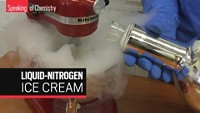Advertisement
Grab your lab coat. Let's get started
Welcome!
Welcome!
Create an account below to get 6 C&EN articles per month, receive newsletters and more - all free.
It seems this is your first time logging in online. Please enter the following information to continue.
As an ACS member you automatically get access to this site. All we need is few more details to create your reading experience.
Not you? Sign in with a different account.
Not you? Sign in with a different account.
ERROR 1
ERROR 1
ERROR 2
ERROR 2
ERROR 2
ERROR 2
ERROR 2
Password and Confirm password must match.
If you have an ACS member number, please enter it here so we can link this account to your membership. (optional)
ERROR 2
ACS values your privacy. By submitting your information, you are gaining access to C&EN and subscribing to our weekly newsletter. We use the information you provide to make your reading experience better, and we will never sell your data to third party members.
Environment
Honoring Dehydrated Food Technologies
Potato flakes created at USDA research center paved the way for convenience foods
by Rachel Petkewich
May 7, 2007
| A version of this story appeared in
Volume 85, Issue 19

The decade following World War II was a pivotal time for American society—and for potatoes. During these years, women, traditionally the cooks in the family, wanted to make mealtimes less labor-intensive.
Some women were entering the workforce and had less time to cook; others had more leisure time and didn't want to spend it peeling, cutting, cooking, and mashing potatoes. Either way, spuds rarely made it to the dinner table, and the U.S. potato market faced trouble.
Chemists and engineers at the Department of Agriculture's Eastern Regional Research Center (ERRC) came to the rescue with instant mashed potatoes. The trick was to dehydrate the tuber, and the processes created to do that would forever change dinner and snack time.
For this pioneering work, ERRC was designated as the 57th National Historic Chemical Landmark in a special ceremony at the Agricultural Research Service (ARS) facility in Wyndmoor, Pa., on April 18.
American Chemical Society President Catherine T. Hunt presented a commemorative bronze plaque to ERRC Director John P. Cherry at the event, which was attended by approximately 500 people.
Representatives from local and state government as well as Gale A. Buchanan, USDA Undersecretary for research, education, and economics, and Antoinette A. Betschart, ARS associate administrator, were present at the ceremony and at a ribbon-cutting event for a modernized chemical and microbiological food safety wing at ERRC that was held the same day.
ARS is an "issue-driven, problem-solving agency," Betschart explained. ERRC, located just outside Philadelphia, is one of four government-funded research centers in ARS. The centers were established with a total of $4 million by an act of Congress in 1938. All four sites have now been designated as chemical landmarks.
ERRC's focus in the 1950s was to convert perishable commodities into stable and handy forms. The three chemical engineers who created potato flakes unknowingly laid the foundation for snack foods such as Pringles potato crisps, which is now a global industry, Cherry said.
In 1956, James Cording, Miles J. Willard, and John F. Sullivan published a multistep process that maintains the structure of the potato cell during cooking and drying. Disintegrated cells make for unpalatable, pasty potatoes, the investigators knew. Here's their process: First, cook peeled potato slices for 20 minutes between 150 and 165 °F to prevent the cells from softening and gelatinizing. Next, cool the potatoes. Then, steam-cook them for 15 minutes to an hour, taking care not to burst the cells and ruin the texture and flavor. During the mashing step, the researchers include additives such as dilute sodium bisulfite to prevent browning. In the final major step, they use a single-drum drier to yield thin potato sheets that are broken into flakes before packaging.
Consumers could add milk or water to reconstitute the flakes, and voilà: instant mashed potatoes, satisfied families, and happy farmers.
For market tests, the University of Maine sent a boxcar of Russet potatoes to ERRC, Sullivan told the audience at the celebration in Wyndmoor. He and his colleagues processed 1,500 lb of potatoes per day in the summer of 1955, packed them in 100-g cans under nitrogen, and shipped these "Maine Potato Flakes" to supermarkets in Binghamton, N.Y., and Johnson City, N.J. Instant mashed potatoes were a smashing success.
Willard left ERRC to take a job offer from an Idaho-based company because, Sullivan said at the ceremony, Willard believed he could contribute more by helping to commercialize dehydrated potato products than by just writing more papers about the topic. In Idaho, Willard helped to establish the first commercial potato flake processing plant for Rogers Brothers Food in 1957. Commercialization "didn't stop the research, just slowed it down," Sullivan said. For example, ERRC eventually found a way to flake the abundant but low-solids eastern potato, too.
The market for processed potato flakes is big. About 10%???or 2.4 billion lb???of the annual U.S. potato crop becomes dehydrated flakes. Large quantities of those flakes are processed for military rations and international food aid programs. USDA also buys millions of pounds of flakes per year for school lunch programs and other domestic food assistance programs.
In the private sector, Willard used the flakes to invent potato crisp products like Pringles, which are made by Procter & Gamble. The global market for such crisps alone exceeded $1.4 billion in 2000.
Willard, who died in 2004, has "his footprint in the cement or on the floorboards" of most flake plants in the world, said Randy Kern, managing partner of Miles Willard Technologies. Willard also created Hula Hoops???not the toy, but a patented fried potato ring made from potato flakes???which continue to sell 2 million bags per day in the U.K. And the company has recently patented a waterless flake technology, according to Kern.
The market for instant mashed potatoes may have peaked, but dehydrated potatoes are also useful for making flour and thickening agents, for everything from pierogies to pizza dough, said Keith Masser, a seventh-generation potato farmer, president of the potato products company Sternman Masser and a past-chair of the U.S. Potato Board.
At ERRC, the dehydration work extended beyond just potatoes. During the 1970s, Cording and Sullivan helped create a new process for dehydrating fruits and vegetables. Dehydration by hot air or freeze-drying is time-consuming and expensive. Cording suggested "explosion puffing" as an alternative; that is, using hot air to dry the produce to 15–35% moisture content and then putting it into a "puffing gun." There, heating the bit of moisture in food causes the bits to expand and pop out with a loud bang.
Eventually, to lower energy costs, a continuous explosion-puffing system was created, initially for dried potatoes and carrots. This work was expanded to apples, blueberries, onions, peppers, and other produce. Today, puffed potatoes are in emergency rations, and carrots are used in dehydrated soups around the world.






Join the conversation
Contact the reporter
Submit a Letter to the Editor for publication
Engage with us on Twitter